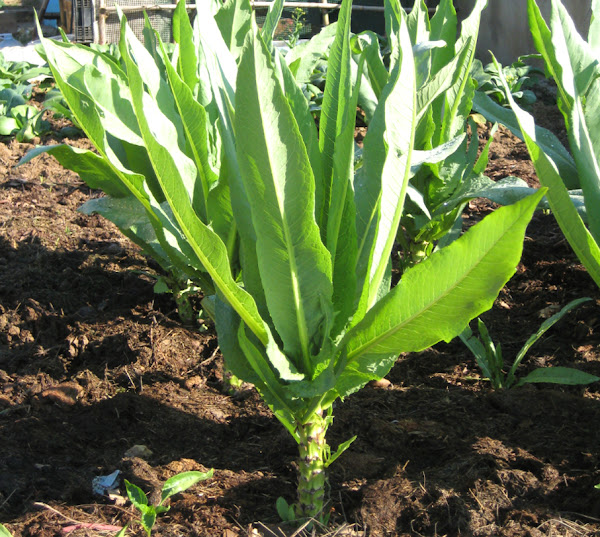Growing celtuce organically in home garden is almost similar to growing lettuce. The celtuce is grown mainly for it’s stem and it looks like a cross between celery and lettuce (that’s why such name).
But celtuce is actually a variety of lettuce which is grown for it’s thick and fleshy stems.
Celtuce (Lactuca sativa var. augustana, angustata, or asparagina) is actually a variety of lettuce originating in China.
It is also known by some other names such as asparagus lettuce, celery lettuce, stem lettuce and Chinese lettuce.
Celtuce is used as a vegetable and it’s very popular especially in both mainland China and Taiwan.
It is also a popular Asian vegetable, but it is gaining popularity throughout the world. In the native area of celtuce, the stem is interchangeably called qingsun or wosun.
Both stems and the green leaves are edible, and can be eaten raw in salads or cooked in many different ways.
It can also be pickled, grilled, stir-fried or roasted. Celtuce is mild but nutty (with a slight smoky aftertaste) and is high in vitamins.
How to Start Growing Celtuce
Growing celtuce organically in home garden can be a great way for enjoying this vegetable.
Growing celtuce is much more similar to growing lettuce. And it’s actually very easy.
Here we are describing everything about growing celtuce organically in home garden from planting, caring to harvesting.
Select a Variety & Purchase Seeds
First of all, select a celtuce variety for growing in your home garden. There are not too many celtuce varieties available to choose from.
Probably there are only 3 varieties available, and you can choose any variety depending on the availability in your area. And then purchase seeds from any of your nearest market or seed supply stores.
There are also some seed suppliers with online stores. So, you can also order the seeds online.
Best Time for Growing Celtuce
Just like lettuce, the celtuce should be planted when the temperature is still cool. In the northern areas, the celtuce seeds are best grown directly into the garden in mid-spring.
And for the southern areas, the seeds should be planted in the autumn for winter harvest. The seeds are generally sown from April to May in most regions.

Selecting Site & Preparing the Soil
Choose a site with full sun exposure and well-drained soil which is rich in organic materials. Celtuce grows well in fertile soil.
So prepare the soil by adding organic materials into it. Till the soil first and then add well-rotted aged manure or homemade compost. And that’s all! The soil is ready for growing celtuce.
Planting
The celtuce seeds are either sown directly into the soil or into a set bed and then transplanted later to the growing site.
In case of growing celtuce by sowing the seeds directly into the garden, sow the seeds about 1/4 inches deep and 4-6 inches apart in rows. And then thin the seedlings later to about 10-12 inches apart. Water the prepared bed after sowing the seeds.
Harden the seedlings before transplanting them outdoors. Then plant the seedlings in rows to about 10-12 inches apart. And the rows should be 1-1.5 feet apart. Water immediately after planting the transplants.
Caring for the Celtuce Plants
Growing celtuce is very easy and the plants generally require less care and management. Although taking additional care will help them to grow better. However, here we are describing more about the caring steps for growing celtuce organically in home garden.
Fertilizing: Celtuce plants don’t require additional fertilization if you have already prepared the soil perfectly by tilling and adding organic materials.
Watering: Keeping the soil constantly moist is important for better growth of the plants. So, water the plants regularly (but not too much, and don’t make the soil wet).
Mulching & Controlling Weeds: Mulching is important for retaining moisture into the soil. And it also helps to control most of the weeds from the garden. So mulch the cultuce garden by using organic materials such as dry leaves, straw, hay or homemade compost.
Thinning: Celtuce plants don’t grow well if they are overcrowded. So thinning is important. You should thin the seedlings to about 10-12 inches apart once the seedlings reach a few inches tall.
Pests & Diseases
Pests and diseases are relatively less in celtuce. But the plants can suffer from aphid attack. Use homemade organic insecticides if you notice any pests in your celtuce garden.
Good sanitation, crop rotation and purchasing high quality seeds are some good ways for preventing diseases.
Harvesting
Both leaves and stems of the celtuce plants are edible. The leaves become ready for harvesting within about 4-5 weeks after planting.
And the stems generally become ready for harvesting when they are about 30 cm tall. But you can also start to harvest when the stems reach about 1 inch in diameter and 12-18 inches tall.
Fresh celtuce stems are crisp, moist and mildy flavored. And the stems are generally prepared by slicing and then stir frying with more strongly flavored ingredients.
These are the common ways for growing celtuce organically in home garden. Hope you have enjoyed this guide! Happy gardening 🙂






